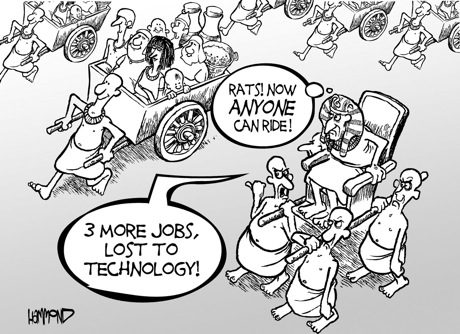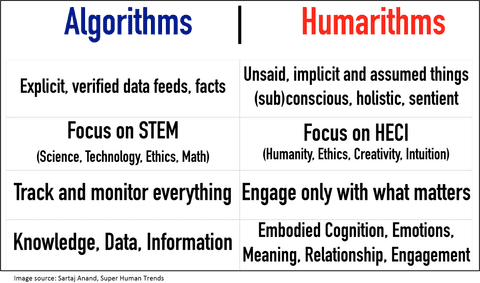Summary: What are the real threats of job loss from real and AI enhanced virtual robots? How do we position ourselves and our children to succeed in this new environment?

Data Scientists Automated and Unemployed by 2025! is the title of an article we wrote almost exactly a year ago. If you thought that job loss due to automation was going to be restricted to traditional industries you’ll need to think again. It’s clear this is going to encompass jobs we thought until recently were immune from automation.
We argued in a recent article that the great majority of job displacement so far has been due to relatively dumb robotics. However the future of automation will rapidly yield to AI enhanced virtual robots.
While automation in all its various forms has been displacing humans since the time of the water wheel, it’s the rate of change that’s different this time. If you are under 30 you may need to reskill or upskill several times during your working life thanks to the accelerating rate of change.
Who Is Most Vulnerable
David Tal the futurist reminds us that robots aren’t really coming to take our jobs; they’re coming to automate routine tasks. Certain jobs that contain routine tasks are easy to spot like file clerks, ticket agents, and typists. But particularly as our AI enhanced virtual robots become more capable the definition of routine expands.
In our recent article about how VCs and business operators spot jobs that are ripe for automation Andrew Ng points at “almost anything that a typical person can do with less than one second of mental thought” is vulnerable. David Beyer, a Partner at VC Amplify Partners says almost every task that is not specifically analytical, social, or interpersonal is at risk. This includes for example a large list of non-routine manual skills like the repair of increasingly complex machinery, or even cognitive skills with a repetitive pattern like setting the pari-mutuel odds at a race track.
Jobs that you think are immune from automation today, may not be so in the future. In the field of data science, platforms like DataRobot and PurePredictive seek to fully automate the creation of the kinds of customer behavior models that are widely used by the largest financial, telecom, insurance, and ecommerce companies. Although the job of data scientist will not go away, many of us especially at a junior level can be replaced by these platforms that allow a few data scientists to do the jobs of many.
How to Spot Jobs that are Not Likely to be Automated
There is relatively broad agreement that there are a few task characteristics that will belong exclusively to humans for many years.
 Analytical Tasks – Building and Repairing Things – Including the Robots: At the top end of this scale (data scientists, and scientists and engineers in other fields) and at the lower end (plumbers, electricians) are tasks that are either heavily analytic or extremely non-routine and therefore safe. This will need to expand to include a category of workers not extant today, those who can repair and maintain both the physical and virtual robots. STEM education and training is the key to this career path.
Analytical Tasks – Building and Repairing Things – Including the Robots: At the top end of this scale (data scientists, and scientists and engineers in other fields) and at the lower end (plumbers, electricians) are tasks that are either heavily analytic or extremely non-routine and therefore safe. This will need to expand to include a category of workers not extant today, those who can repair and maintain both the physical and virtual robots. STEM education and training is the key to this career path.- Interpersonal Tasks – Dealing with or Leading People: These jobs range from leadership positions, to sales, coaching, or any other calling that requires building a longer term rapport with other humans and emotional intelligence (EQ). Add to the list teachers, medical and psychological professionals, consultants, and any other roles where absorbing large amounts of conflicting data, factoring in verbal, non-verbal, and visual clues, social skills, and the ability to filter these through the lens of life experience. However, our virtual robots are becoming better and better at short and reasonably empathetic exchanges like customer service reps and some care givers. So safety lies at the top of this scale, and also at the bottom with the least repetitive and most unstructured relationship tasks.
- Creatives: We are not saying that society will make room for more artists, writers, and musicians (too bad). These creatives will increasingly be found in the STEM specialties and in business where new products, services, processes, and structures will be needed to adapt to and lead the change.
There are two other criteria that sometime appear in these discussions but we are skeptical. They are “Accountability” and “Liability” as suggested by the futurist David Tal.
His line of thought is that as a society we will want to have specific humans ‘accountable’ for specific actions like doctors prescribing medicine or police officers arresting drunk drivers. His thought on ‘liability’ is that as a society we will always want a human to hold responsible if a product or service creates an injury or fails to meet an agreed standard. Acts that today might generate a lawsuit.
I am less persuaded by these factors which seem to be part of our current social model but don’t account for how we may change. Self-driving cars will be an interesting test case. For example, no-fault auto insurance emerged in the 80’s in response to social change. And where we become convinced that our AI systems make better and more consistent decisions than humans (AI now able to better classify images than humans) we may adopt new ways of thinking and new social protections that protect human health, safety, and freedom alongside more capable robot augmentation. These developments will no doubt come later than sooner.
What are Some Specific Jobs That Will Resist Automation?
From a survey of current articles on the topic, here’s a quick and non-exhaustive list of jobs mentioned by several other authors that they believe will resist automation.
- Business Manager and Executives
- Computer Systems Analysts
- Delivery Truck Driver
- Dentists
- Director of Food and Nutrition Services
- Hotel Room Cleaners
- Mechanical Engineers and Technicians
- Midwifes
- Nurses
- Organic Farmer
- Physicians
- Psychiatrists
- Registered Nurses
- Robotics Engineers and Technicians
- Skilled trades and repair: plumbers; builders; electricians; heating, ventilation and air-conditioning installers; automotive technicians
- Therapists
- University Professors
- Writer, Artists, Musicians, Designers
Professions involving Information Technology
- AI and Robotics Leads
- Data Scientists, Visualizers, Analysts
- Digital Marketing Professionals
- Gamification Designers
- IoT Manager
- Network and Data Engineers
- Product Developers
- QA Analysts
How Long Will This Last
 The first thing to think about is how rapidly advances in AI are now coming. Yes we are largely in the ‘statistical’ phase 1 and ‘cognitive’ stage 2 of AI. No we don’t know when or even if Artificial General Intelligence will be achieved but even if we never advance beyond the current phase, these capabilities will continue to expand.
The first thing to think about is how rapidly advances in AI are now coming. Yes we are largely in the ‘statistical’ phase 1 and ‘cognitive’ stage 2 of AI. No we don’t know when or even if Artificial General Intelligence will be achieved but even if we never advance beyond the current phase, these capabilities will continue to expand.
The second consideration is social acceptance. Take caregivers for example. For now we are inclined to carve out this fairly routine area as a profession immune to automation largely because of the need for emotional intelligence, aka ‘the human touch’. However, just as children under the age of 9 have never known a world without smart phones, the time is not very far off (perhaps two decades) when a new generation may only know automated caregivers, and they may find that both natural and acceptable.
Solutions, Challenges, and Silver Linings
Surely there are challenges. Just as unemployed and under employed coal miners and manufacturing workers are dissatisfied today; others will join their ranks in the future. Society (government) will need to adapt safety structures and certainly aid in training and reskilling. That may have to happen several times over a working life.
There are those like Robert Reich, ex-White House official and currently Professor of Public Policy at UC Berkeley who see this in only the most dire of terms. “The problem is not the number of jobs, it’s the quality of the jobs both in terms of income and job security…lower wage less secure jobs are an inevitable result of technology”. His challenge is how to enable people to live better even if they have lower incomes, and his proposal is a universal guaranteed income. That is a very bleak view of the future and a very draconian solution.
Consider this, although 35% to 45% of jobs that existed in 2010 may be at risk of automation, according to the US Department of Labor, 65% of the jobs people will be doing have not even been thought of yet. Volker Hirsch, a well-known VC in the UK quoted these job ads he’d recently seen:
- Memory augmentation therapist
- Plant educator
- Nano-weapons specialist
- Diffractive optics modeler
No I can’t tell you exactly what these do but I am sure they are a reflection of new opportunities available in the future.
On the one hand, if you look at any college or high school curriculum you will not find educational goals that highlight the heightened need for empathy, creativity, or critical thought required to prosper in the presence of automation. That will have to change.
On the other hand we should not see automation as a threat or an adversarial force. David Tal, the futurist sums this up nicely.
“In fact, for those with more complex jobs, automation is a huge benefit. Remember, productivity and efficiency is for robots, and these are work factors where humans shouldn’t be competing against anyway. By hollowing out your job of wasteful, repetitive, machine-like tasks, your time will be freed to focus on more strategic, productive, abstract and creative tasks or projects. In this scenario, the job doesn’t disappear—it evolves.”
This is the third article in our series on the impact of AI and automation on the future of work. See also:
A Robot Took My Job – Was It a Robot or AI?
You may also be interested in this earlier article:
Data Scientists Automated and Unemployed by 2025!
About the author: Bill Vorhies is Editorial Director for Data Science Central and has practiced as a data scientist and commercial predictive modeler since 2001. He can be reached at:

 Analytical Tasks – Building and Repairing Things – Including the Robots: At the top end of this scale (data scientists, and scientists and engineers in other fields) and at the lower end (plumbers, electricians) are tasks that are either heavily analytic or extremely non-routine and therefore safe. This will need to expand to include a category of workers not extant today, those who can repair and maintain both the physical and virtual robots. STEM education and training is the key to this career path.
Analytical Tasks – Building and Repairing Things – Including the Robots: At the top end of this scale (data scientists, and scientists and engineers in other fields) and at the lower end (plumbers, electricians) are tasks that are either heavily analytic or extremely non-routine and therefore safe. This will need to expand to include a category of workers not extant today, those who can repair and maintain both the physical and virtual robots. STEM education and training is the key to this career path.